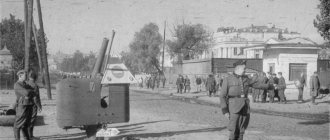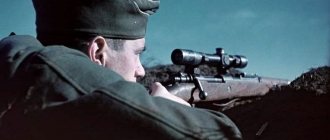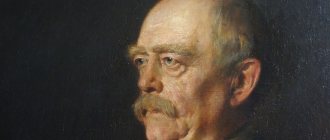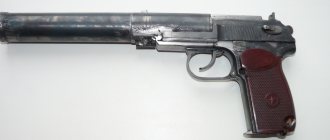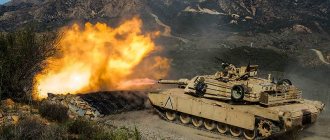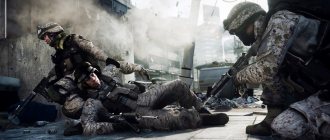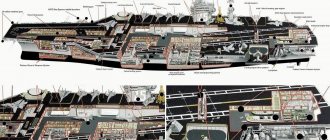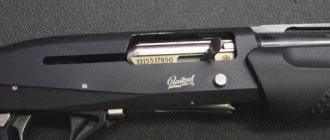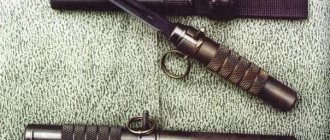Ural hunter
And there is nothing special about the origin of the hero. The events of Zaitsev's childhood could only predict that he would make a good shooter. And so - his pre-war biography is short and simple.
Vasily Zaitsev was born in 1915 in the village of Eleninka (today Chelyabinsk region). His grandfather was an avid hunter. He gave his grandson his first gun (at age 12!) and became his mentor (strict) in shooting. Vasily's parents were peasants. But he himself did not want to inherit the peasant farm. Vasya studied at school for only 7 years, but then he entered a technical school and learned to become a fitter. Later he completed more accounting courses.
Vasily Grigorievich Zaitsev was drafted into the army in 1937.
But the beginning of his military biography did not hint that he would become a legendary sniper. Zaitsev began to serve in a field as far removed from sniper business as possible - in the navy, and even... as a clerk!
Clerk Vasya
It was about accounting training. Vasily served as a clerk in the artillery department and at the same time studied at the Military Economic School. After graduation, he received the honorary, but “non-military” position of head of the financial department.
Until now, military financiers are proud that the famous hero of the Battle of Stalingrad is rightfully included in their “workshop”. And although he left a “grain” position for the sake of the Stalingrad trench, he connected his post-war life with leadership work, and financial experience was not superfluous to him. The shooter also valued the fact of his service at sea. He remembered the Pacific Fleet with warmth, and throughout the war he wore a vest under his uniform, even though this was not according to the regulations.
Stalingrad infantryman
Although in peacetime Vasily Grigorievich Zaitsev was satisfied with a financial position, during the war it seemed unacceptable to him to be away from battles. The request to be sent to the front was not accepted immediately, but he showed persistence - he submitted 5 (!) reports to be sent as a volunteer. The request was granted only in 1942. The need to ensure replenishment of the troops at Stalingrad can be considered one of the main reasons for this decision of the command.
Zaitsev did not undergo any special sniper training (although there were sniper schools in both Germany and the USSR).
And he joined the army as an ordinary infantry soldier. The only advantage over other conscripts was hunting training. As a clerk, he did not devote much time to combat training. Therefore, the sniper’s feat is not the result of good “pumping”, but of personality traits and special innate talent.
In the fall of 1942, during the defense of Stalingrad, Zaitsev demonstrated excellent aimed shooting skills. He used the usual “three-line” rifle - the Mosin system rifle. Personal “records” in the Red Army were meticulously recorded, but the command acknowledged the fact that he had destroyed at least three enemy soldiers from a distance of 800 m (this is a lot for a non-specialized rifle, even by modern standards), and in total in the first days the number of Nazis killed by Zaitsev reached 32 Human.
The feat was appreciated by the command. The fighter was awarded a medal, paid a monetary reward and presented with a real sniper rifle. The infantryman became a sniper. No preparation. I just took it and started doing it.
Who was "Koning"?
Historian Alan Clark identified König as the head of the sniper school in Zossen, SS Standartenführer Heinz Thorwald. And the Briton Frank Ellis, in the book “The Stalingrad Cauldron”, published by the University of Kansas, assures that no “super sniper” existed at all. He draws attention to the inconsistency in Zaitsev’s story - in the evening the sun could not shine on Koenig’s face, since the German positions were in the west, and the Soviet ones in the east. However, this author can be suspected of bias towards the Red Army soldiers, because Ellis is close to European far-right circles. In addition, there were areas on the front line in Stalingrad where the Germans found themselves geographically east of the Russians.
Stalingrad hunt
The Battle of Stalingrad provides an example of particularly effective sniper teams. Zaitsev’s heroic comrades-in-arms (snipers) numbered in the dozens, and during the months of particularly stubborn fighting at Stalingrad, they destroyed about 6 thousand enemy soldiers.
At the same time, Vasily not only personally engaged in “hunting”, but also led other snipers, showing them examples of correct battle tactics.
It is important to remember that Zaitsev was virtually self-taught in sniper business, but quickly became famous. The art of a sniper is not only the ability to accurately hit a target from a long distance. Any trained shooter with experience can do this. And the sniper’s task is not the same as that of an ordinary soldier. He must carry out the orders of the command, and in the process destroy any enemy he can. The sniper deals with especially cautious and protected targets - officers, spotters, and other snipers.
And perhaps the main thing in his skill is to be able to choose the right position and remain on it for hours without moving, preventing himself from being detected by the enemy. You need to be able to disguise yourself, your weapons and your intentions.
Zaitsev developed several new techniques in this area and improved existing ones. Some of his inventions are still in use today.
Vasily Zaitsev considered it necessary for the sniper to frequently change positions, but in such a way as not to impair visibility of the target. According to his method, positions should have been looked after during a lull, and not when there was already an order to act.
Zaitsev was strict about the issue of target detection. He rechecked the object several times to eliminate mistakes and not accidentally destroy a low-value enemy, leaving the true target intact. He did not fire at random to alarm the enemy. If this was required for the sake of completing a task, he entrusted the task to his partner. Vasily himself took every shot responsibly. But he knew and successfully used techniques designed to force the enemy to shoot inaccurately and reveal himself.
At the same time, to detect the enemy, Zaitsev used the laws of ballistics - he studied the direction and angle of the bullet hitting a false target (helmet, mitten, item of clothing). In terms of tactics, he believed that a sniper should be able not only to destroy the enemy, but also to defend himself - the living are more useful.
Who was "Koning"?
Historian Alan Clark identified König as the head of the sniper school in Zossen, SS Standartenführer Heinz Thorwald. And the Briton Frank Ellis, in the book “The Stalingrad Cauldron”, published by the University of Kansas, assures that no “super sniper” existed at all. He draws attention to the inconsistency in Zaitsev’s story - in the evening the sun could not shine on Koenig’s face, since the German positions were in the west, and the Soviet ones in the east. However, this author can be suspected of bias towards the Red Army soldiers, because Ellis is close to European far-right circles. In addition, there were areas on the front line in Stalingrad where the Germans found themselves geographically east of the Russians.
So there is no reason to doubt the veracity of Zaitsev’s story. If only because he didn’t say anything special. Major Koenig was not a “superman,” and the two Soviet snipers he shot remained alive. Other Soviet marksmen also met with various “super snipers.” For example, sniper Ilya Grigoriev told the writer Vladimir Karpov about a “duel” with a certain Hans, which ended in favor of the Red Army soldier.
Source
Mentor of the young
During the Great Patriotic War, the Soviet sniper trained dozens of young replacements personally - first directly in the trenches, then at the sniper school. But his experience did not go away with him; it is still used in the army.
Zaitsev is the author of two textbooks on sniper business.
They are successfully used in training modern snipers (and therefore are classified, a random person cannot view them on the Internet). He also wrote memoirs - a valuable source on the history of Stalingrad and sniper combat. “Notes of a Sniper” is a popular book that makes an impression even on modern youth who are far from the realities of war.
Until old age, sniper Vasily Zaitsev retained his faithful eye and steady hand. The hero's biography contains such an episode. He was 65 years old when he was invited as a guest of honor to the sniper school for the graduation of cadets. During the demonstration shooting, the veteran (almost as a joke) was asked to “show his class” to the young ones. Zaitsev took a rifle from one of them and knocked out 30 points with three shots. As a result, the award for excellent shooting was given not to the best graduate, but to the guest of honor.
The most famous episode of Zaitsev’s Stalingrad biography is a duel with a German ace, a master sniper. It was even used as the basis for film scripts. Sniper fire at Stalingrad worried the Nazis. They also knew about the sniper Vasily Zaitsev as a particularly formidable enemy. Therefore, it is generally accepted that the “specialist from Berlin” arrived specifically to “hunt the Hare” - demonstrative destruction of the best enemy and demoralization of the rest.
Sources agree that he was a famous professional. But they disagree on the question of what his name was. It seems that he had documents with him in the name of Erwin Koenig. But they showed signs of being fake. Therefore, British researcher Alan Clark believes that Zaitsev’s opponent was Colonel Heinz Thorwald, the head of an elite sniper school. Whatever his name, he was a strong opponent. But he clearly had not hunted hares before and did not know that experienced hunters considered this a dangerous activity.
Only a specialist can understand in detail the beauty of Zaitsev’s fight with the German ace.
To put it briefly, the Berlin guest challenged the enemy by killing two Soviet snipers in one day. He camouflaged himself perfectly and was distinguished by enviable patience.
Zaitsev used his entire arsenal against him - analysis of the enemy’s actions, changing positions, false attack of his partner, study of hitting a false target. As a result, for a short moment he was able to see part of the enemy’s head, and this was enough for a single shot.
Fame came to him immediately, but did not save the hero from the vicissitudes of fate. Soon after the fight with the Berliner, Zaitsev was seriously wounded and temporarily lost his sight. The Moscow Filatov Clinic solved the problem through operations and long-term treatment. He had to change his profile, but he continued his service - he headed a sniper school and commanded a mortar crew. He liberated the Donbass, participated in the crossing of the Dnieper, and ended the war in Kyiv - however, in a hospital bed, after another wound.
Sign in OK
1. “The most famous sniper of Stalingrad, of course, is Vasily Zaitsev, who killed 242 German soldiers and officers, including the head of the Berlin sniper school, Major Konings.”
2." When our intelligence officers captured the prisoner, he reported that the European champion in bullet shooting, the head of the Berlin sniper school, who had received the task of destroying Soviet snipers, and above all, the “main Hare,” as the fascist soldiers began to call him, had been flown to the Stalingrad area from Berlin. »
3. “Major Koenings, head of the Berlin sniper school, was urgently called to headquarters. In the general's office, the conversation began straight away. “You know, Major, Russian snipers at Stalingrad have become completely insolent - they are shooting the Fuhrer’s officers. Maybe you can put things in order there yourself? You are a famous sniper. The general glanced briefly at the major’s tall figure, clearly appealing to his vanity. Koenings stretched out obsequiously in front of the general and clicked his heels. - Mister General, I will take care of this myself. Report to my Fuhrer, I will hunt for Soviet snipers there.”
Although the image certainly exists (photo 1), it raises serious doubts. However, we see this “Koenig” standing next to the Germanophobe Eisenhower in 1944.
Even more likely, such an ace would have used a rare Carl Zeiss Jena Zielsechs six-power telescopic sight. (photo 4)
And thirdly, it is argued that Koenig was the European shooting champion, but they began to be held in 1955.
In each company, some soldiers were armed with rifles with telescopic sights, but did not have any special training. But they fired at distances of up to 400m and reliably hit targets.
And finally, Koenig is not on the list of snipers. Just like Torvald, who is often passed off as Koenig.
"Fictional snipers "Erwin König", "Heinz Thorwald" and "Sulo Kolkka" are not included in the list."
Source
Sniper iconostasis
Zaitsev Vasily Grigorievich - Hero of the Soviet Union, winner of two Orders of the Red Banner and the Order of the Patriotic War, medals “For Courage” and “For the Defense of Stalingrad”. Until his death, he was an honorary citizen of Volgograd.
He is depicted in the “Battle of Stalingrad” panorama, and a monument was erected to him in his native village.
Based on the biography of the legendary sniper, 2 feature films were made (including the foreign film “Enemy at the Gates”). His activities are reflected in the exhibition of the Stalingrad Defense Museum.
The question of how many fascists the fighter destroyed is still open. Officially, he was credited with 225 enemy fighters for the period from November 10 to December 17, 1942. Rumors attribute twice the result to the hero, and it is probably greater than even these assumptions. But then there was a war, and this was not a record in sniper business - there were Soviet snipers who made more successful shots. But Zaitsev was distinguished by the highest “rate of fire” - he achieved his result in a short time.
The sniper rifle of Vasily Zaitsev became famous no less than its owner.
She was nothing special - an ordinary army sample. Now Vasily Zaitsev’s rifle is in the Museum of the Battle of Stalingrad. But several more types of weapons are associated with the sniper’s name:
- Mosin rifle - he started with it;
- Dragunov’s “snipers” - he helped test them;
- fictional super rifles from several modern computer games.
True, the “sofa” heroes of computer battles did not learn one thing - a sniper rifle needs a sniper, preferably a strong man with an established psyche, and not an overgrown “child”.
The post-war years passed successfully for the hero. He stayed in Kyiv - nationality was not important in his time. Vasily graduated from the Institute of Light Industry, ran a garment factory, and was in administrative work.
In Kyiv he got married and started a family.
But his relationship with independent Ukraine did not work out. The sniper died on December 15, 1991 - 2 weeks after the independence referendum. He was buried in Kyiv against his will. And only in 2006 the ashes were transferred to Volgograd (according to the wishes of Zaitsev himself). And that’s the thing - could he calmly lie in the immediate vicinity of the street named after the Ukrainian nationalist Olena Teliga (there is one not far from the Lukyanovsky memorial cemetery)?
Now the sniper is resting on Mamayev Kurgan. And the words of Vasily Grigorievich Zaitsev “There is no land beyond the Volga!” are considered the most accurate reflection of the essence of the Stalingrad epic.
Death from the oven
From the very first battles in Stalingrad, Zaitsev established himself as an excellent shooter. Fighting with an ordinary “three-line”, he destroyed 32 Nazis. For this, Zaitsev was awarded the medal “For Courage”, and along with it he received a sniper rifle.
The Battle of Stalingrad differs from others in that it developed into a months-long street battle, where the methods of conventional warfare were ineffective. As a result, small assault groups and snipers became the main striking force in these battles.

